
The Class D50 is a type of 2-8-2 steam locomotive built by the Japanese Government Railways (JGR), the Japanese National Railways (JNR) and various manufacturers from 1923 to 1931. The class name indicates that the locomotive has four sets of driving wheels (D) and belongs to one of the classes of tender locomotive allocated a number in the series 50 to 99 in the Japan Railways locomotive numbering and classification scheme of 1928.

The China Railways JF6 class steam locomotive was a class of 2-8-2 steam locomotives for freight trains operated by the China Railway. They were originally built in Japan and Manchukuo between 1934 and 1944 for the South Manchuria Railway (Mantetsu), the Manchukuo National Railway, and the North China Transportation Company.

The China Railways SL6 class steam locomotive was a class of 4-6-2 superheated two-cylinder passenger steam locomotives operated by the China Railway. Originally built for the South Manchuria Railway (Mantetsu), the Manchukuo National Railway, the Central China Railway and the North China Transportation Company by several Japanese manufacturers between 1934 and 1940, they were the most numerous class of steam passenger locomotive in China, with 422 eventually built.
The China Railways SL2 class steam locomotive was a class of 4-6-2 passenger steam locomotives operated by the China Railway. They were originally built for the South Manchuria Railway (Mantetsu), where they were designated Pashini (パシニ) class.

The China Railways SL3 class steam locomotive was a class of 4-6-2 passenger steam locomotives operated by the China Railway. They were originally built for the South Manchuria Railway, the Manchukuo National Railway and the North China Transportation Company by several Japanese manufacturers between 1934 and 1940. They were designed in 1933 based on the design of the first Pashisa class locomotives ; the first order was placed by Mantetsu in March of that year.
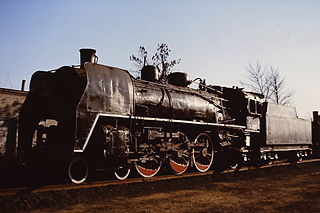
The China Railways SL5 steam locomotive was a class of 4-6-2 passenger steam locomotives operated by the China Railway. They were originally built for the South Manchuria Railway in 1927 and 1928.

The China Railways AM1 class locomotives were a class of 4-4-0 passenger steam locomotives operated by the China Railway, originally built for the South Manchuria Railway (Mantetsu). The "Ame" name came from the American naming system for steam locomotives, under which locomotives with 4-4-0 wheel arrangement were called "American".
The Manchukuo National Railway Tehosa class steam locomotives were a class of 4-6-0 passenger steam locomotives operated by the Manchukuo National Railway. Originally built for the South Manchuria Railway (Mantetsu), they later transferred to the MNR. The "Teho" name came from the American naming system for steam locomotives, under which locomotives with 4-6-0 wheel arrangement were called "Ten-Wheeler".
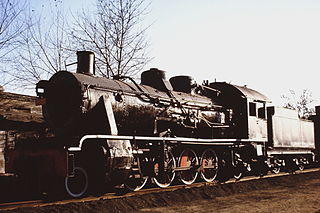
The China Railways JF3 class steam locomotive was a class of 2-8-2 steam locomotives operated by the China Railway, built by the Škoda Works in Czechoslovakia in 1927–1930.
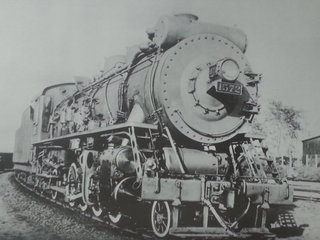
The China Railways JF1 class steam locomotive was a class of 2-8-2 steam locomotives for freight trains operated by the China Railway. They were originally built in the United States, Japan and Manchukuo between 1918 and 1945 for the South Manchuria Railway (Mantetsu), the Manchukuo National Railway, the North China Transportation Company, and the Central China Railway. After the end of the Pacific War, they were taken over by the China Railway, the Korean State Railway in North Korea and by the Korean National Railroad in South Korea, and more were built in China after 1949 for the China Railway, which ultimately operated over 2,000 of the type.
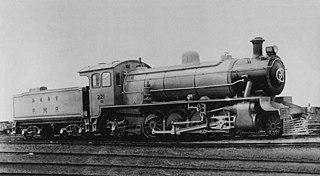
The China Railways JF7 class steam locomotive was a class of 2-8-2 steam locomotives operated by the China Railway, built by the North British Locomotive Company and assembled by the Tangshan Arsenal, as well as American builders between 1913 and 1924.
The China Railways JF12 class steam locomotive was a class of 2-8-2 steam locomotives operated by the China Railway, built by the ALCo in the United States in 1922.
The China Railways JF5 (解放5, Jiěfàng, "liberation") class steam locomotive was a class of 2-8-2 steam locomotives operated by the China Railway, originally built by Kawasaki in Japan in 1923 for the Jichang Railway.
The China Railways JF13 class steam locomotive was a class of 2-8-2 steam locomotives operated by the China Railway, built by the Škoda Works in Czechoslovakia in 1939.
The China Railways JF15 class steam locomotive was a class of 2-8-2 steam locomotives operated by the China Railway, built by the American Locomotive Company in the United States in 1928−1929.
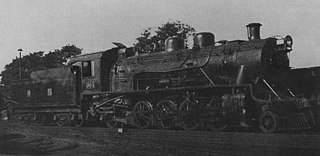
The China Railways JF17 class steam locomotive was a class of 2-8-2 steam locomotives operated by the China Railway, built by Hudswell Clarke in the United Kingdom and by the South Manchuria Railway's Shahekou Works in 1931.
The China Railways JF18 class steam locomotive was a class of 2-8-2 steam locomotives operated by the China Railway, built by the American Locomotive Company in the United States in 1914.
The China Railways AM3 class steam locomotive was a class of 4-4-0 steam locomotives operated by the China Railway, built by the American Locomotive Company in the United States between 1923 and 1929.

The Mikasa-class (ミカサ) locomotives were a group of steam tender locomotives of the Chosen Government Railway (Sentetsu) with 2-8-2 wheel arrangement. The "Mika" name came from the American naming system for steam locomotives, under which locomotives with 2-8-2 wheel arrangement were called "Mikado" in honour of the Emperor of Japan, as the first 2-8-2 locomotives in the world were built for Japan.

The Pashishi class (パシシ) locomotives were a group of steam tender locomotives of the Chosen Government Railway (Sentetsu) with 4-6-2 wheel arrangement. The "Pashi" name came from the American naming system for steam locomotives, under which locomotives with 4-6-2 wheel arrangement were called "Pacific".












